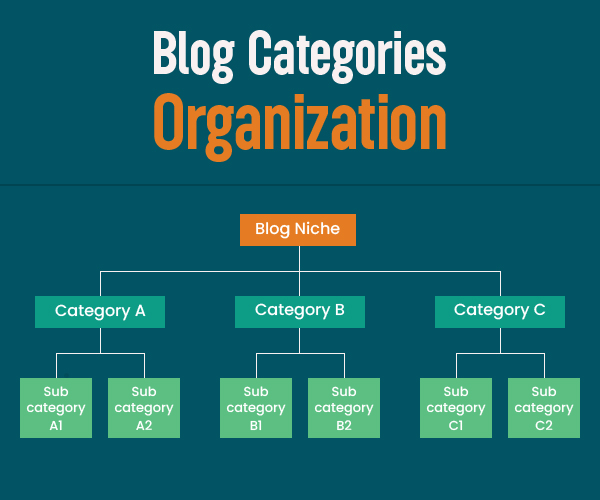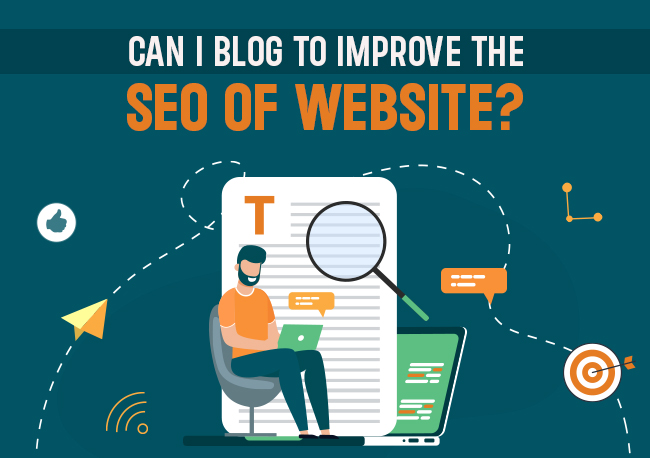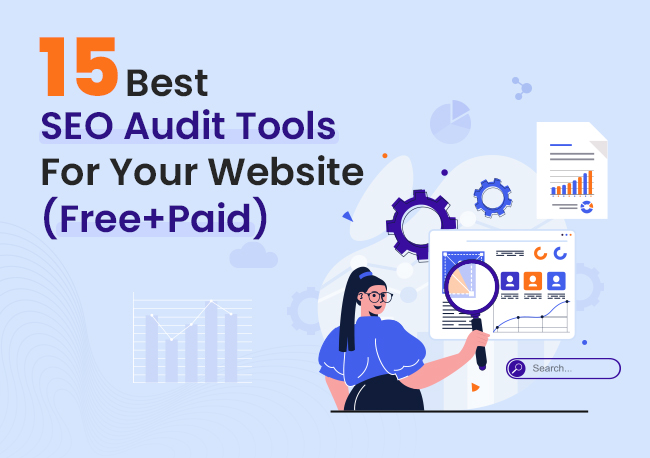Rankings have always been a primary concern for website owners. Regardless of the nature of your business, you hope to stay at the top of your game, which in this case are rankings. While there are numerous ways to boost the rankings, many repeatedly ask this one question — Can I blog just to improve a website’s SEO?
To answer your question once and for all, we have drafted this detailed guide that explains whether or not relying solely on blogging can bring all the things your website deserves — visibility, an increase in conversion rate, and drive sales.
Before hopping to the main question, let’s first understand the basic dynamics of content in SEO. .
What Is The Role Of Content In SEO?
Content plays a major role in SEO. This one strategy can make or break opportunities for you. Meaning, if it is well-structured, offers quality and relevant reading, has appropriate and balanced keyword stuffing, and solves the purpose of users’ visiting your content, it can drastically enhance your site’s visibility on SERPs.

According to Heidi Cohen, “ideal content” is high-quality, useful information that conveys a story in a contextual and relevant manner with the goal of soliciting emotion or engagement.
Despite what Cohen said, numerous pieces of content on the Internet don’t match Google’s guidelines. In turn, the published content is not offering the desired results as website owners expect.
Now that you know the role of content in SEO, Let’s understand how does blogging help SEO
Also Read: Does My Website Need a Blog – A Detailed Overview
12 Areas Blogging Can Improve In SEO
- Helpful in Brand Awareness
- Helpful in Driving Traffic
- Plays a Crucial Role in Page Indexing
- Great for Customer Acquisition
- Keeps Website Fully Up-to-date
- Best for Targeting Long-tail Keywords
- A Great Way for Link Building
- Helpful in Showcasing Expertise
- Enhances Social Media Presence
- Best for Long-term Growth
- Helpful in Increasing Engagement
1. Helpful in Brand Awareness
The most apparent and vital goal that can be achieved by blogging is brand awareness.
Now blog posts help SEO?
While many blogs can guide you in creating relevant, quality, and keyword-rich content for brand awareness, we will give you different perspective on how do blog posts help SEO.
Following the fundamentals are absolute for brand awareness. You are supposed to draft content on user-relevant and trendy topics that solve user queries. You have to be consistent with your blogging strategy to get benefits in SEO & brand awareness as well. Post content regularly on your website and third-party sites to gain user engagement.
The potential of content marketing is limitless. Once you start posting, solving user queries through blogs, and comprehending the basic ideas of blog writing, your content will gradually appear at the top. Users will read the blog, and that’s how they will learn about your company and its offerings.
Also Read: Is Starting a Blog Worth in 2024?
2. Helpful in Driving Traffic
The prior goal of SEO is getting higher traffic & blogging helps you in achieving that SEO goal. When we say blogging can acquire traffic, we don’t mean any traffic. You will observe relevant traffic and a targeted audience reading your content and visiting your site.
Although to appear in the search results, you have to target the right audience in your content and draft industry-specific & meaningful content that grabs users’ attention.
Besides following these, you must promote your content on the right platforms, such as social media & third-party sites, followed by targeting a relevant audience, covering keywords searched by your audience, and link-building of your sites on other powerful sites.
Mind you; this is not an overnight process. Keep patience, and you will see how blogs are good for SEO.
Also Read: How Much Traffic Does this Website Get? 7 Ways to Check
3. Plays Crucial Role in Page Indexing
There are millions of websites and webpages on the Internet today, but are they all indexed? Google has always been open about its page indexing ways. It claims that it doesn’t index all the pages it crawls, and there are various vital reasons for it. Some pages have 404 errors, while some don’t provide relevant information, and the remaining pages have thin or duplicate content.
At the same time, multiple pages are indexed and ranked on the SERPS. The fact is they avoid all the drawbacks of indexing and ensure the content has relevancy and is regularly updated. Google analyzes content to find meaning and indexes to make it rank on the SERPs. The same is advised for you to follow.
Also Read: What Is A Sitemap & Why Do You Need It?
4. Great For Customer Acquisition
If your ultimate goal is to acquire leads and increase your conversion rate, blogging is a reliable and effective way to do so. Blogging is one of the most preferred methods to generate inbound leads. Ensure that your blogs have opt-ins. This includes offering a freebie, promo codes, and so on to drive customers to your site and take action.
Add the hyperlink to your product/service page in the blogs. While doing so, don’t forget that the links should appear natural. Write a blog mentioning to promote your services or products.
Draft content surrounding your industry type. Supposedly, you are a skincare brand. You would draft content on industry topics such as 12 skincare products for oily skin or 5 best ways to eliminate acne, and naturally highlight the benefits of your products. Such seamless branding would drive customers to your website to check out the products.
Creating and promoting ads about your products/services/company on your blogs is also a great way to customer acquisition. Lastly, don’t forget to build and try out new strategies for customer acquisition.
5. Fully Up-to-date Website
Let’s say you type ‘5 social media trends of 2023’ in the search engine. You will get a list of blogs, articles, and web pages on the same topic. Upon clicking on one of the links, you see the content is not the latest would you continue reading it? No, right. You will head to a different page to find the information.
This, too, can happen with your website if your content is not updated. Your website needs new content to drive traffic and be indexed, just as blogs do.
Search algorithms want fresh and engaging content to drive traffic and increase the user session time. Websites that are updated regularly are given more priority. We suggest you regularly add new blogs to keep your website updated.
Also Read: Website Optimization Tips To Increase Website Performance
6. Best For Targeting Long-tail Keywords
As mentioned previously, being at the top has always been a priority of web owners. However, it is a tough nut to crack. You must ensure that your content comprises the fundamentals, including long-tail keywords.
Did you know that 56% of buyers prefer to add three or more words in the search engines, while 7% use a single-word acronym to search? By looking at these statics, you might have understood the value of optimizing your content for long-tail keywords.
It might seem awkward and unnatural to add some long-tail keywords to your product and service pages, but optimizing them in blogs is easy, convenient, and natural. These search terms are perfect for blogs, articles, and other long forms of content.
Adding long-tail keywords to your blogs can attract targeted traffic to your site which is beneficial for SEO. For instance, you have a clothing website, and your targeted keyword is — Trendy women’s clothes to attract female shoppers to shop from your site. Fitting this keyword into your product or service page might seem a little unnatural.
However, forming a blog on the same topic as your keyword and fitting it to your content would be a great idea to generate targeted traffic on your site.
Also Read: Complete Guide To The Content Management System
7. A Great Way For Link Building
The process of link building does not only help with generating traffic, but it also helps in increasing high-quality inbound leads and SEO ranking. Earlier search engines used to read the text on the site to rank a page/site. However, times have changed now.
Search engines prioritize content and links on the website/webpage. They act like votes. Quality links have a greater chance of ranking higher in SERPs.
In order to gain quality links, you have to do guest posting, interview experts and influencers, show relevancy in your articles, use statistics, and develop keyword-rich pages. Besides following these strategies, ensure to create valuable and engaging content.
Also Read: How Is Ranking Different When Comparing PPC Vs SEO?
8. Helpful in Showcasing Expertise
If you want to put your expertise at the forefront, blogs are just the right way in doing so. This long form of content will highlight your expertise in a crowded field, which in this case, is your competitors. To do so, you have to research your competitors and see what types of blogs they are writing and what keywords they use. You also need to do industry research to find blog topics.
Suppose you are a digital marketing agency. You will search other digital agency competitors, check out their blog topics, search industry trends, and finally draft content comprising those ideas. You can also draft content on your journey, social media trends, marketing strategies, and countless other subjects.
You can also promote your expertise, offerings, and why clients/customers should leverage your firm in the blogs.
9. Social Media
Did you know you can capitalize by sharing blogs on social media? If you look at your social media, you might realize people share job openings, service/product videos, promotional content, informative videos, etc. But why are they sharing on social networking sites? Well, of course, to capitalize.
Upon sharing posts on social media, users can check them out and click on the link to your site to view your offerings. This way, you can drive traffic through your social media. Besides the referral traffic, regular posting will showcase your active social media presence and keeps your audience engaged.
Moreover, social signals and Google search algorithm is correlated. Hence posting and promoting blogs on social media will also improve your rankings on SERPs.
10. Best For Long-term Growth
Success isn’t overnight. It’s when every day you get a little better than the day before. It all adds up. This quote by Dwayne Johnson is perfect for this topic – long-term growth through blogging. Blogging is a time-consuming process that shows results over a period of time.
Patience, dedication, and hustle are needed to witness growth through blogging. You need to build effective content strategies and post content at recurring intervals. Once you successfully complete the initial phase of your journey, You will witness surging traffic on your site daily which will last for a longer period.
Also Read: Does Buying Traffic To Your Website Work?
11. Helpful in Increasing Engagement
Is your site receiving less traffic? Are your users not staying for enough duration on your site? Then, it’s high time you post blogs to increase engagement. If you are an existing or forthcoming web owner, you might know blogging is a great way to interact with your target audience and increase their engagement on your site.
Although posting is not enough, you have to bring in engagement by drafting relatable and high-quality content that focuses on the concerns of your audience. Always be consistent with your content. Post regularly, and you will see the magic of the increased engagement in a short time.
Do keep in mind to share original content. Never share duplicate or thin content, as search engines will disregard the content and disrupt your ranking.
You also have to invite users to comment and share your blog to increase engagement. Responding to the comments and appreciating for sharing the content is a must. Pay attention to what users say and their reactions, as it will help in user engagement and loyalty.
Also Read: Is Starting a Blog Worth in 2024?
12. Builds Credibility And Authority
While we mentioned how do blog posts help SEO, we will also showcase how they can establish credibility among your target audience and authority over your site. Readers and search engines always look forward to hearing insights from expert and relatable writers to gain knowledge on their search queries.
When you post quality content, craft compelling titles and headlines, and draft clickbait descriptions that have relevancy, eventually, the frequency of readers will increase on your site. If your posted content is relatable and accurate, readers will trust and follow your blog posts, gradually increasing your readers base.
Besides this, it also helps with building brand authority. The increased traffic upon regular blog posting related to your niche will eventually boost your ranking score on SERPs. Numerous big brands, such as Neil Patel, Hootsuite, Grammarly, Ahrefs, Mailchimp, and so on, ensure posting blogs related to their industry to attain authority. Doing so increases the 50% chances of a visitor converting into a customer.
Now that we have discussed how does blogging help SEO, let’s check out the best blogging practices.
Let’s Have a Recap, How blogging can improve in SEO with an Infographic below:

Also Read: How Much Does It Cost To Start A Blog In 2023
11 Best Blogging Practices For SEO
1. Keyword Research
Keywords have a significant impact on SEO and are equally vital for content. While we have previously mentioned focusing on targeting long-tail keywords, you must also heed attention to other keywords, such as short-tail keywords and LSIs.
Conduct keyword research with the help of SEO tools, put the relevant ones in the Excel sheet, and finally, use them in your content. Ensure you draft content after comprehensive keyword research. This ensures you use the right, high-ranking, and most searched keywords in your content. These search terms also add value to your content since they are the search terms used by your target audience to search for information on the SERPs.
Also Read: What Are The Benefits Of A Website For Small Businesses
2. Originality Is The Key
Never disregard originality in your content. Original content is valuable for users and crucial for search engines. The authenticity of your content ensures that it is based on facts that attract your targeted readers to follow your site.
If your content is plagiarized, it won’t rank on search engines. On top of that, it will disrupt your rankings and, eventually, your business because very few web users head to a site ranked behind on search engines.
Don’t forget to check and modify your content on plagiarism-+checking tools such as Quetext, Grammarly, Small SEO Tools, Duplichecker, etc. For starters, you can use the free version, which will give you almost accurate results on whether or not your content is plagiarized.
As soon as you grow your site, you can buy the paid version, which will give precise result and the correct source of plagiarism.
Also Read: 15 Best SEO Audit Tools For Your Website (Free+Paid)
3. Focus On SEO And Audience
Many writers and website owners wonder this most common question, who should be their sole focus when writing content – audience or SEO? We say your write-up should focus on both. While SEO will boost the position of your site/page on search engines, the targeted audience will help achieve your desired goal.
Ensure your blog content is written by following the best SEO practices, such as relevant keyword, defined structure, and originality. At the same time, it should be engaging, provide valuable insight, and be easy to comprehend for your target audience.
4. Organize Your Content
Grouping content into different categories based on their subjects makes seamless navigation. But why do we organize content? As a marketer or a writer, you post endless content in a day or month. Do you know how difficult it becomes to manage?
Let’s say you post 1000 articles in a month. By the end of the year, you will easily post 12,000 articles. Now, wouldn’t it be easy if you categorized them for seamless navigation for you and your readers? Of course, it would.
For organizing your content, you can follow tagging and categorizing methods. Categories are pre-defined structures used for sorting or grouping posts into different categories. You can categorize them as top-level categories, subcategories, and so on.

As for tags, they are relatively different from categories. Users can type phrases or words in the tag bar to find a blog.

Using these methods, both users and you can easily search for a specific topic or post.
5. Avoid Keyword Stuffing
Besides choosing the right set of keywords, Following the best keyword practices for SEO is also important. Keyword stuffing should always be balanced.
Many marketers and writers follow the outdated practice of filling a web page with the same keywords multiple times to manipulate rankings in search engines. However, this is not at all beneficial. In fact, Google categorizes such content as over-optimized, negatively impacting your ranking.
Instead of following this outdated practice, we recommend you include the required keyword density and divide the keywords into primary, secondary, and tertiary, likewise fitting them accordingly.
Don’t forget to include primary keywords in the meta tags, titles, and first lines of the content.
Also Read: Best Practices To Secure Your Website
6. Focus on Readability
Many writers and marketers draft overly swanky content to entice spectators. Was the previously written line difficult to read? The same happens when you use heavy words to grab the user’s attention. Although, the result is the exact opposite of what was expected.
Since users can’t understand what was written, they tend to move to the next site. To avoid the same happening to you, ensure your content has easy readability. Use synonyms of words but the ones that go hand in hand with the sentence and theme of the topic.
For instance – when writing a real estate blog, using words like curb appeal, luxurious, home, and apartment would make more sense. However, if you use words like abode, commuter, and so on would not justify the theme of the topic. On top of that, it can change the entire meaning of the sentence while making it difficult for a reader to understand.
It is recommended to structure the content of a blog easily and simply while choosing the right tone and set of words.
7. Keep Internal And External Linking
Internal and external linking refers to attaching a hyperlink to content. To give an individual overview, internal linking is a process of linking a URL of your webpage to another webpage of your site. External linking refers to linking a URL of your website/webpage to a third-party site.
Now, Why Are They Important For SEO?
Internal linking helps users and search engines easily find pages included in your website. This also boosts rankings on search engines. At the same time, external links help with credibility. When your site or a web page is liked on other authoritative sites or pages, it signals search engines that your site provides high-quality and valuable content, and that’s how you can reach the top on SERPs.
All in all, internal and external linking is necessary to drive traffic and showcase to web users that your site has E-A-T (expertise, authoritativeness, and trustworthiness).
8. Create Appealing Visuals
Did you know content having relevant images generates 94% more views? With this statistic, you might have an idea of visuals’ power in marketing. Compared to written content, visuals give your audience a better appeal and understanding to your audience. You must create a mix of written and visual content to engage your audience.
Compelling visuals do not mean you will include irrelevant images, infographics, videos, or other visual content. You have to ensure that your uploaded creatives resonate with the theme of the topic or the particular point you are explaining.
Ensure the creatives have a high resolution. At the same time, it should not be heavy for the website as it might negatively impact the speed of your site.
9. Offer Detailed Information
Regardless of the topic, remember that your content should solve the purpose of the user visiting your website. It should be detailed enough so that users can get all the information on the particular topic they searched.
For instance – a user searches for 5 skincare products to use this summer for oily skin, and if you have a blog on a similar topic, it should solve the user’s query. You cannot recommend 5 products and move on. You must ensure that your blog explains the benefits and disadvantages and covers the topics relevant to the blog so that the users can gain all the required information.
This also helps with the rankings. When your blog is well-defined and detailed, Google crawlers scan and index it, ranking it on the top of SERPs.
10. Effective URL Structure
For numerous web users, URL structure is merely an address to a site. However, let us tell you, URL structure is more important than you think. Over the years, numerous practices have been recommended to form an effective URL structure. Wondering why? Your URL structure can positively impact the ranking. Hence, forming an SEO-friendly URL structure is imperative to ensure your site appears at the top of the SERPs.
Ensure that your URL is relevant to the theme of your website/webpage. Use the HTTPS protocol to encrypt the communication between your browser and the website. Keep it short and simple, use lowercase letters, & hyphens, and include meaningful keywords.
Considering these certain aspects will help in easy comprehension for search engines as well as web users.
11. Focus on Website Speed
Regardless of the nature of your business, optimizing website speed is critical for SEO. According to Google, they pay attention to a site’s speed because faster sites lead to happy users. However, low-speed sites can disrupt the user experience, making them spend less time on the site. Hence, they encourage web owners and all internet users to consider optimizing site/page speed to appear at the top of the rankings.
High speed also ensures an impressive user experience. As mentioned above, users stay on a site with a quick response. A faster site equates to reliability, professionalism, and an excellent first impression, which makes a reader want to visit the site frequently. This will also help in building a loyal reader base.
Considering these certain aspects will help in easy comprehension for search engines as well as web users.
Now that you know how does blogging help SEO and what are its best practices. Let’s dive straight into mistakes you must avoid when blogging for SEO.
Let’s Have a Recap, What are the best blogging practices for SEO with an Infographic below:

Also Read: Do I Need Privacy Policy For My Website In 2023
12 Mistakes To Avoid When Blogging For SEO
- Undefined Target Audience
- Unmatched Search Intent
- Targeting ‘Too Difficult’ Keywords
- Inadequate Backlinks
- Inconsistent Posting
- Too Much Self-promotion
- Missing Out On SEO Practices
- Not Linking Other Sites
- Monotonous Content
- Avoid Keyword Stuffing
- Avoid Plagiarized Or Thin Content
- Neglecting Mobile Optimization & Site Speed
1. Undefined Target Audience
Never disregard your targeted audience when writing blogs. Many writers and marketers assume their content will perform well even if they don’t consider their target audience. But that’s where they go wrong. When you define your target audience, your content appears better.
Upon personalizing, readers can’t relate to your personality and style of writing. Plus, your content will solve the purpose of their query/visit since you have researched and addressed the queries of your target audience.
Identifying the target audience is equally crucial when you are blogging for SEO. When you write a piece of content based on the queries and demands of your target audience, they would want to visit your website frequently, leading to increased traffic and ranking on the search engines.
All in all, identifying your tribe of readers is a must for achieving success in SEO.
Also Read: Difference Between Target Audience and Target Market
2. Unmatched Search Intent
Why do writers or marketers share content on the internet? The purpose is to educate, share knowledgeable insights, and mainly to solve the concern of users reading your blog. What if your content doesn’t solve the problem of your target audience? You will lose your visitors and readers base simply because your content does not provide value.
You must draft high-quality content that answers EXACTLY what users want. For instance – if a user searches – How to create a social media calendar and if you have a blog on a similar topic, it should include all the details and steps for creating a social media calendar.
3. Targeting ‘Too Difficult’ Keywords
Many writers and marketers are unaware that keyword difficulty can impact their content strategy and rankings on search engines. You cannot choose a keyword based on high search volume alone. You also need to consider the other supporting keywords.
For instance – Despite writing a blog on the cake, you chose to add chocolate cakes as a keyword based on high search volume hoping it would bring traffic to your site. However, it didn’t bring you desired results because you relied on a single keyword to rank. At the same time, they appeared on the top because they understood the keyword difficulty and used other keywords as a backup.
Rather than only targeting too difficult keywords, you should leverage other keywords to support your content.
4. Inadequate Backlinks
The right amount of backlinks on your site can help enhance your digital reputation and empower your site on search engines. But what happens when you don’t have sufficient backlinks on your site? It can dramatically impact your SEO efforts, thereby reducing your rankings on the SERPs.
Hence, we advise you to have a sufficient amount of backlinks on your site to not experience such circumstances. While you consider the quantity, we also recommend you check the quality of the backlinks because high-quality and relevant backlinks can improve rankings and site authorization.
5. Inconsistent Posting
One mistake that every writer and marketer should avoid is inconsistent posting. You must bear in mind that consistent blog posting equates to increased ranking on search engines. Regularly sharing relevant and meaningful content on distinctive topics keeps your audience engaged, and they visit your site more frequently.
You might not see results in a short interval. However, regular posting is a long-term process. Be consistent, and you will observe enormous growth in your organic traffic.
Experts suggest posting blogs twice or four times a week is a sure-shot way to increase interaction with your target audience.
6. Too Much Self-Promotion
You might have noticed that many blog posts promote their brand name or services/products in every second paragraph. While self-promotion can be a nice touch in your content, too much can hurt your brand. Too much bragging will put off readers. They will avoid reading your content and lead forward to the next site, which as a blogger or marketer, you don’t want.
Hence, self-promotion should be thought of subjectively. Put yourself in the shoes of your audience and see if you would like reading content that constantly sings praises of how good their company is, how much benefit you can get by hiring them, and so on.
Also Read: How SEO and SEM Work Together?
7. Missing Out On SEO Practices
Are blogs good for SEO? Yes, they are! However, it’s paramount to follow the best SEO practices to rank on SERPs. Now, this doesn’t mean there are 3 or 5 practices that can be incorporated into your blogs. Several practices need to be considered to achieve desired results.
Supposedly, if you write quality content and don’t use relevant keywords, you won’t be able to rank at the top of search engines. Ensure your posts have everything – quality content, relevant keywords, featured snippets, and so on. Check out the best blogging writing practices we have mentioned above.
Also Read: How Does Server Location Have An Impact On Your Website SEO?
8. Not Linking Other Sites
Not including links to other sites is one of the biggest mistakes that should be avoided in blogs. Linking relevant links can certainly increase the credibility of your blog post. Previously in the best SEO practices, we mentioned Google prioritizes blogs with relevant links.
Links demonstrate that your content is well-researched, based on facts, and connected with relevant resources. Linking is beneficial in achieving the trust of your target audience as the additional resources related to your content provide them valuable information on their search query.
9. Monotonous Content
Would you want to read blog posts that are regular and repetitive? No, right? Like you, your target audience wants variety in content to sustain their engagement. Writing blogs on a variety of topics will boost engagement and traffic.
Let’s assume your blogs are related to fashion and lifestyle. You can draft blogs on fashion trends, best lifestyle habits, fashion mistakes to avoid, fashion guide, and many others. Readers love to hear about different subjects. Experimenting with a variety of topics will keep them engaged and interested.
Moreover, it will also increase user interaction.
10. Avoid Keyword Stuffing
We have mentioned this point countless times and will continue to do so as we want to educate as many readers as possible to avoid keyword stuffing. This outdated practice is unreliable and can impact your SEO growth. You have to be mindful of keyword stuffing to ensure your site doesn’t end up in an over-optimized category.
Always focus on crafting quality content with a balanced ratio of relevant keywords that fits naturally. Wondering how many keywords a website can have? It’s all about choosing the right balance to target your audience effectively without overloading your pages. This is a productive and reliable way to boost SEO and achieve long-term growth.
11. Avoid Plagiarized Or Thin Content
Remember never to post thin or plagiarized content online. Search algorithms and readers look forward to reading valuable insights that can be useful to them. Content with minimal to zero use will be considered low quality and worst, can be penalized or deranked.
This is why ensure that your blogs are relevant and have zero plagiarism. If there are posts with thin or plagiarized content, make sure to fix them right away.
12. Neglecting Mobile Optimization & Site Speed
Did you know 60.67% of website traffic comes from mobile devices? Google has constantly been updating web owners to prioritize mobile optimization since it will be crawling your mobile site. Pay attention to main web vitals, manage missing content, and fix UX issues.
Besides this, consider site speed. Slow loading website can disrupt the user experience and impact rankings. Generally, the page rendering should be in less than a second. To do so, clean your pages, make them simple to navigate, eliminate page errors, resize & compress creatives, host on a reliable web hosting platform, use native technologies, and remove unnecessary files & folders.
Don’t forget to measure the speed on PageSpeed Insights, Lighthouse, and similar tools.
Let’s Have a Recap, What to avoid when blogging for SEO with an Infographic below:

Also Read: Importance Of Mobile-Friendly Website & How Do You Make It?
Conclusion
We hope this blog gave you an answer to How do blog posts help SEO. If you plan to pursue blogging as a full-time career, ensure that you realize the SEO potential for blogs. Blogging is a lucrative field when combined with SEO.
However, you need to ensure that you follow the best SEO practices mentioned above and, most importantly, be patient. Patience and perseverance will lead to success.




